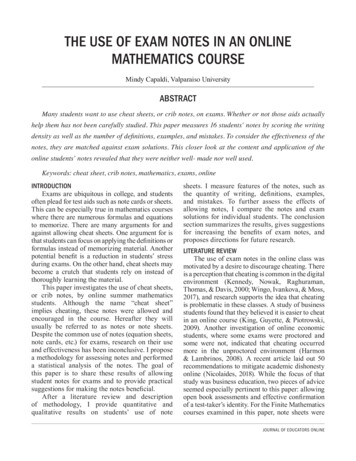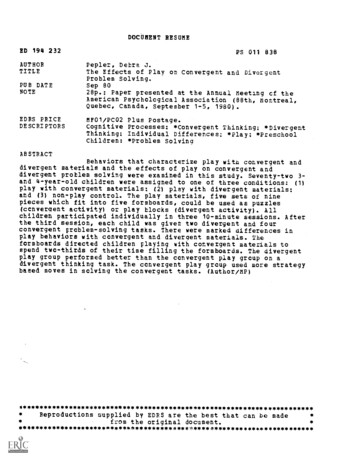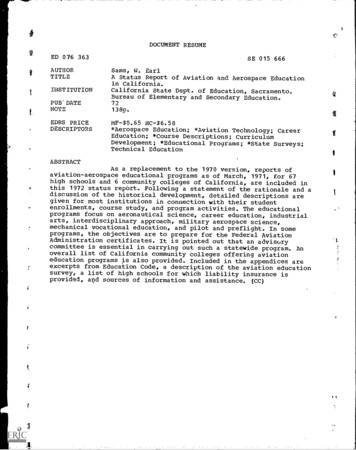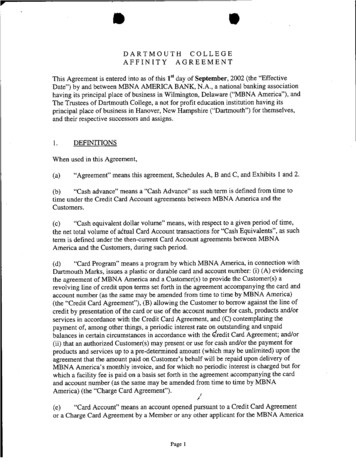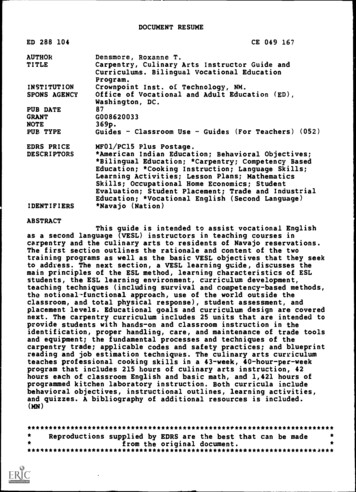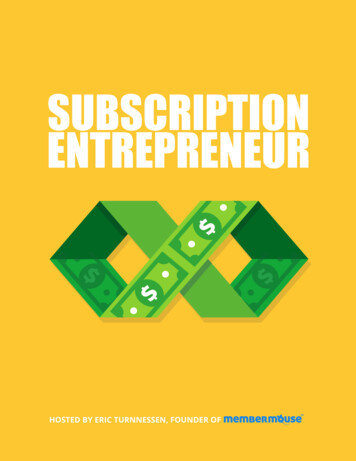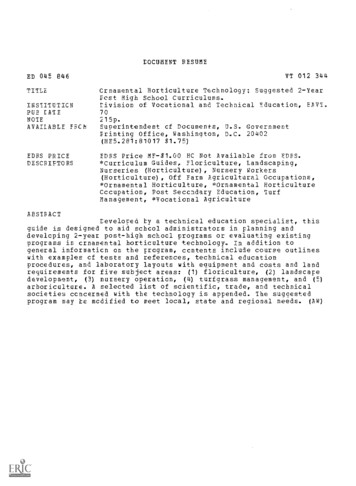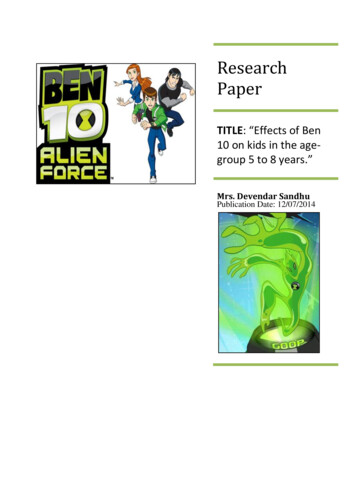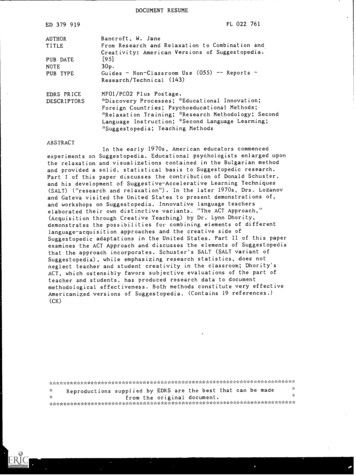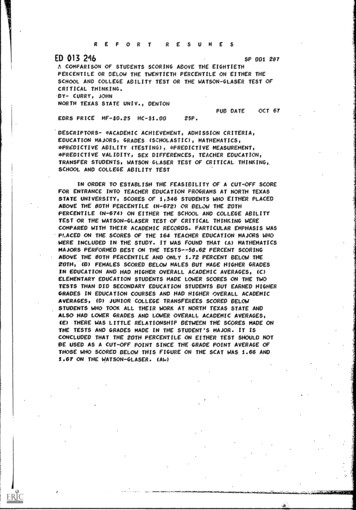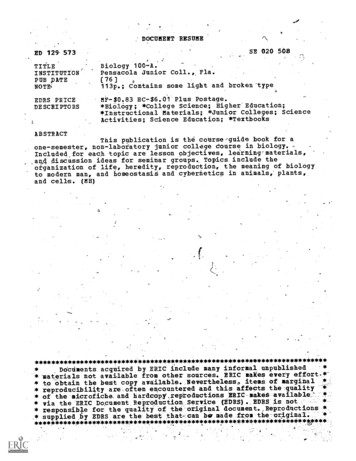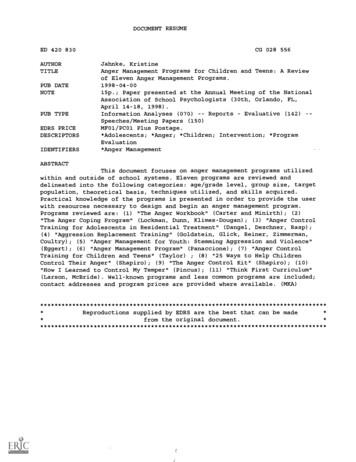
Transcription
DOCUMENT RESUMECG 028 556ED 420 830AUTHORTITLEPUB DATENOTEPUB TYPEEDRS PRICEDESCRIPTORSIDENTIFIERSJahnke, KristineAnger Management Programs for Children and Teens: A Reviewof Eleven Anger Management Programs.1998-04-0015p.; Paper presented at the Annual Meeting of the NationalAssociation of School Psychologists (30th, Orlando, FL,April 14-18, 1998).ReportsEvaluative (142) -Information Analyses (070)Speeches /Meeting Papers (150)MF01/PC01 Plus Postage.*Adolescents; *Anger; *Children; Intervention; *ProgramEvaluation*Anger ManagementABSTRACTThis document focuses on anger management programs utilizedwithin and outside of school systems. Eleven programs are reviewed anddelineated into the following categories: age/grade level, group size, targetpopulation, theoretical basis, techniques utilized, and skills acquired.Practical knowledge of the programs is presented in order to provide the userwith resources necessary to design and begin an anger management program.Programs reviewed are: (1) "The Anger Workbook" (Carter and Minirth); (2)"The Anger Coping Program" (Lockman, Dunn, Klimes-Dougan); (3) "Anger ControlTraining for Adolescents in Residential Treatment" (Dangel, Deschner, Rasp);(4) "Aggression Replacement Training" (Goldstein, Glick, Reiner, Zimmerman,Coultry); (5) "Anger Management for Youth: Stemming Aggression and Violence"(Eggert); (6) "Anger Management Program" (Panaccione); (7) "Anger Control"25 Ways to Help ChildrenTraining for Children and Teens" (Taylor)(8)Control Their Anger" (Shapiro); (9) "The Anger Control Kit" (Shapiro); (10)"How I Learned to Control My Temper" (Pincus); (11) "Think First Curriculum"(Larson, McBride). Well-known programs and less common programs are included;contact addresses and program prices are provided where available. ************************************Reproductions supplied by EDRS are the best that can be madefrom the original ***************************************
U.S. DEPARTMENT OF EDUCATIONOffice of Educational Research and ImprovementEDUCATIONAL RESOURCES INFORMATIONCENTER (ERIC)"PERMISSION TO REPRODUCE THISMATERIAL HAS BEEN GRANTED BY0 This document has been reproducixt as\-kk(VteC-1-.received. from the person or organizationoriginating it.0 Minor changes have been made to improvereproductionisCment do not necessarily represent officialOERI position or policy.00C1Points of view or opinions stated in this docu-TO THE EDUCATIONAL RESOURCESINFORMATION CENTER (ERIC)."ABSTRACTC'44.1A REVIEW OF ANGER MANAGEMENT PROGRAMS FOR CHILDREN AND TEENSKRISTINE JAHNKE, M.Ed.MEDINA CITY SCHOOLSKENT STATE UNIVERSITYThis presentation will focus on anger management programs utilizedwithin and outside of school systems.Ten programs will be reviewedand delineated into the following categories:age/grade level, groupsize, target population, theoretical basis, techniques utilized, andskills acquired.Well known programs(e.g.Goldstein and Glick'sAggression Replacement Training) and less common programs(e.g. JohnTaylor's program on anger control training) will be reviewed in orderto provide the participants with an array of informationon angermanagement programs.Participantsprograms.can expectto gain practicalknowledgeof these tenReview of the efficacy and utility of these programs willalso provide the participant with a variety of resources necessary tobegin such a program of their own design.LC)LIDODCVCDCDA comprehensive table willbe provided to participants which can be utilized as a menu from which
selectionofanselection process,appropriate program can be made.Through thisparticipants will be able to piece togetheracustomized anger management program which is appropriate for the skilllevel and the group targeted for the intervention.3
ANGER MANAGEMENT PROGRAMS FORCHILDREN AND TEENSA REVIEW OF ELEVEN ANGERMANAGEMENT PROGRAMSKRIS JAHNKE, M.Ed.
1THE ANGER WORKBOOKDr. Less Carter and Dr. Frank MinirthThomas Nelson PublishersISBN 0-8407-4574-5Less than 20.00Age/Grade Level:High School children and adultsGroup Size:Not specifically designed for a group but thethirteen steps could be incorporated into agroup format; 4-6 is preferableTarget Population:Adolescents and adults with the ability to selfreflect on their behaviors and thoughtsTheoretical Basis:Not specifically statedStrongly cognitive in natureBalance in life is found when anger is linked to areasonable issue and is communicated in aproper mannerTechniques Utilized:ChecklistsQuestions following short case examplesSelf-reflection stimulated by questionsSkills Acquired:Able to identify the best ways to handle angerGain an understanding of how other emotionsfeed angerUncover and eliminate myths that perpetuateangerIdentify learned patterns of relating, thinking, andbehaving that influence anger5
2THE ANGER COPING PROGRAMJOHN E. LOCKMAN, SUSANNE DUNN, BONNIE MIMESDOUGAN 1Age/Grade Level:AdolescentsGroup Size:4-8 children18 weekly sessions for 45 minutes to 1 hour2 group leaders (school co-leader and a mentalhealth clinic worker)Target Population:Adolescents identified by school personnel ashighly disruptive or aggressiveTheoretical Basis:Based on Dodge's Model of how a childperceives and then decides how to react toproblematic social situationsTechniques Utilized:DiscussionRole-playingVideo tapingGoal settingVideo tapesSkills Acquired:Can engage in perspective takingHave an awareness of physiological arousalCan engage in self-instruction to inhibitimpulsive respondingCan engage in social problem solving1 Lochman, J.E., Dunn, S.E., & Klimes-Dougan, B. (1993). An intervention and consultation model from a socialcognitive perspective: A description of the anger coping program. SchoolPsychology Review, 22(3)., 458-471.6
ANGER CONTROL TRAINING FOR ADOLESCENTS INRESIDENTIAL TREATMENT 'Age/Grade Level:AdolescentsGroup Size:6-10 members; 6 session one hour eachTarget Population:Adolescents and adults with the ability to selfreflect on their behaviors and thoughtsTheoretical Basis:Cognitive BehavioralTechniques Utilized:Thought stoppingRelaxationSkills Acquired:Knowledge of what causes anger to build-upStep by step self-questioning to determine theproblem, alternatives, and the best solution'Dangel, R.F., Deschner, J.P., & Rasp, R.R. (1989). Anger control training for adolescents in residential treatment.Behavior Modification, 13(4). 447-458.
4AGGRESSION REPLACEMENT TRAININGGoldstein, A.P., Glick, B, Reiner, S., Zimmerman, D., & Coultry, T.(1986). Aggression replacement training. Champaign, IL: ResearchPress.Approximately 20.00Age/Grade Level:AdolescentsGroup Size:6-12 childrenTarget Population:Juvenile delinquentsChildren labeled as aggressiveTheoretical Basis:Cognitive BehavioralTechniques Utilized:Skills training componentAnger control training componentMoral educationSkills Acquired:How to:Express complaintsRespond to the feelings of othersPrepare for a stressful conversationRespond to angerKeep out of fightsHelp othersDeal with accusationDeal with group pressureExpress affectionRespond to failure8/
5ANGER MANAGEMENT FOR YOUTH: STEMMING AGGRESSIONAND VIOLENCEDr. Leona EggertNational Educational Service (800) 733-6786 22.95Age/Grade Level:High school children; written for use in highschools but "can be easily adapted for diversepractice settings"Group Size:Group leader-student ration of no more than 1 to12Target Population:The book recommends identifying students fromschool records, a drop in GPA of .7 or more inone, or from school personnel who canidentify the child as "at risk" of school failureTheoretical Basis:Cognitive BehavioralWhen provoked to anger we respond at threelevels: thoughts, feelings and behaviorsTechniques Utilized:Objectives are utilized to guide each sessionIntegration of 2 submodels: group supportsystem and life skills trainingSkills Acquired:Ability to see that problems are an opportunityfor change and growthLinking thoughts, feelings and behaviorsDiscovering what pushes anger buttonsDiscovering consequences of angry outburstsLearning inoculations against angerThought stoppingSelf-talk scripts9
6ANGER MANAGEMENT PROGRAMLinda Panaccione, LISWNo costAge/Grade Level:Advanced middle school, high school, and adultGroup Size:4-6 students are ideal; one on one is alsoappropriateTarget Population:High functioning, self-reflective adolescents andadultsTheoretical Basis:Cognitive BehavioralTechniques Utilized:One simple technique describing anger as a tenstep processSkills Acquired:The ability to recognize triggers and determinereplacement behaviors to engage in when triggersoccuri0
7ANGER CONTROL TRAINING FOR CHILDREN AND TEENSJohn F. Taylor, Ph.D.Available from mar-co products inc.Less than 20.00Age/Grade Level:4th through 12th grade; may be adapted for K-3Group Size:Can be done classroom-wide, in a group of 3-8children or with an individual childTarget Population:Any child; best with impulsive, quick-to-angerchildrenTheoretical Basis:CognitiveAnger is an energizing, self-protective, emotionalresponse to a perceived, likely or actual, hurtfrom a stressorTechniques Utilized:Led by teachers, parents, counselors, orpsychologistsModelingDiscussionConcern notebooksAcronymsSkills Acquired:Ability to define angerAbility to discover ways to express angerAbility to correctly manage anger11
25 WAYS TO HELP CHILDREN CONTROL THEIR ANGERLawrence E. ShapiroChildswork/ChildsplayFree with orderAge/Grade Level:6-adultGroup Size:Not specifically created for groupsTarget Population:Almost any childTheoretical Basis:Majority are cognitive behavioralTechniques Utilized:RelaxationFighting fairGamesHandoutsSkills Acquired:RelaxationRecognition of feelings and emotionsAwareness of behaviorAwareness of behavioral triggers
THE ANGER CONTROL KITLawrence E. ShapiroChildswork/Childsplay 84.95Age/Grade Level:6-adultGroup Size:Not specifically created for groupsTarget Population:Almost every populationTheoretical Basis:Covers six "modalities"1. Affective2. Behavioral3. Cognitive4. Developmental5. Educational6. SocialTechniques Utilized:38 techniquesVideotape is included to provide demonstrationsof the techniques in actionBroken record, fighting fair, feelings vocabulary,peer mediation, stop and thinkSkills Acquired:Variety of skills acquired depending on thetechniques utilizedSelf-regulationHow to express feelingsStress managementPeer mediation
,HOW I LEARNED TO CONTROL MY TEMPERDebbie PincusChildswork/Childsplay(800) 962-1141 16.95Age/Grade Level:Kindergarten to Elementary SchoolGroup Size:Not specifically created for groupsTarget Population:Less severe childrenTheoretical BasCognitive behavioralTechniques Utilized:Worksheets that involve coloring, games, andwritingSkills Acquired:Recognition of angry feelings/expressionsHow to cope with angry feelingsHow to control your temperAssertiveness trainingEmpathy for other children
11THINK FIRST CURRICULUMJames Larson, Ph.D., NCSP and Judith McBride, Ph.D.Department of Psychology University of Wisconsin-Whitewater800 West Main StreetWhitewater, WI 53190Age/Grade Level:Middle School and High School ChildrenGroup Size:Not specifically stated; 6-10 in generalTarget Population:Youth demonstrating angry, aggressivebehavior in the school settingTheoretical Basis:Cognitive behavioral frameworkTechniques Utilized:Playing of a video tape with modelsScript is provided for facilitatorsA-B-C ModelHomework (Hassle log)Game playingRole playingCertificates of reward for reaching goalsSkills Acquired:Anger reduction methods(deep breathing)Students examples of aggressive incidentsChildren learn the physiological "cues" to angerIdentify direct and indirect provocationsInsight into the effects of mis-attribution of intentAssertion techniquesThink ahead procedure for anger controlStructured problem-solvingSelf-evaluation techniques15
ERICU.S. Department of EducationOffice of Educational Research and Improvement (OERI)National Library of Education (NLE)Educational Resources Information Center (ERIC)REPRODUCTION RELEASE(Specific Document)I. DOCUMENT IDENTIFICATION:Title: angerAuthor(s):PrO9rOMS cor C,h\lacen n od TeensKr 1 5 \--me, M, )abnKe,Corporate Source:Publication Date:WASP P reset-NA-0Aion4/qaII. REPRODUCTION RELEASE:In order to disseminate as widely as possible timely and significant materials of interest to the educational community, documents announced in themonthly abstract journal of the ERIC system, Resources in Education (RIE), are usually made available to users in microfiche, reproduced paper copy,and electronic media, and sold through the ERIC Document Reproduction Service (EDRS). Credit is given to the source of each document, and, ifreproduction release is granted, one of the following notices is affixed to the document.If permission is granted to reproduce and disseminate the identified document, please CHECK ONE of the following three options and sign at the bottomof the page.The sample sticker shown below will beaffixed to all Level 1 documentsThe sample sdcker shown below will beaffixed to all Level 2A documentsThe sample sticker shown below will beaffixed to all Level 2B documentsPERMISSION TO REPRODUCE ANDPERMISSION TO REPRODUCE ANDDISSEMINATE THIS MATERIAL HASBEEN GRANTED BYDISSEMINATE THIS MATERIAL INMICROFICHE, AND IN ELECTRONIC MEDIAFOR ERIC COLLECTION SUBSCRIBERS ONLY,HAS BEEN GRANTED BYPERMISSION TO REPRODUCE ANDDISSEMINATE THIS MATERIAL INMICROFICHE ONLY HAS BEEN GRANTED BY\eSaTO THE EDUCATIONAL RESOURCESINFORMATION CENTER (ERIC)TO THE EDUCATIONAL RESOURCESINFORMATION CENTER (ERIC)TO THE EDUCATIONAL RESOURCESINFORMATION CENTER (ERIC)2A1Level 12BLevel 2ALevel 2B11Check here for Level I release. permitting reproductionand dissemination in microfiche or other ERIC archivalmedia (e.g. electronic) and paper copy.Check here for Level 2A release. permitting reproductionand dissemination in microfiche and in electronic mediafor ERIC archival collection subscri
Dr. Less Carter and Dr. Frank Minirth. Thomas Nelson Publishers ISBN 0-8407-4574-5 Less than 20.00. Age/Grade Level: Group Size: Target Population: Theoretical Basis: Techniques Utilized: Skills Acquired: High School children and adults. Not specifically designed for a group but the . thirteen steps could be incorporated into a group format; 4-6 is preferable. Adolescents and adults with the .
